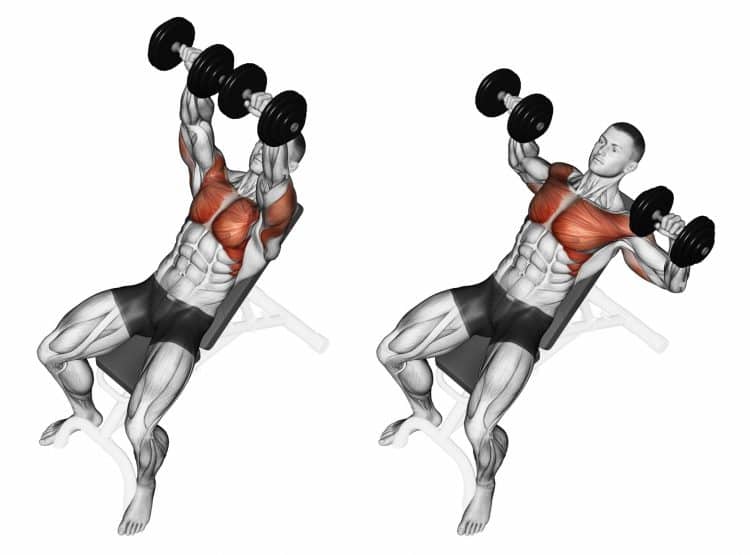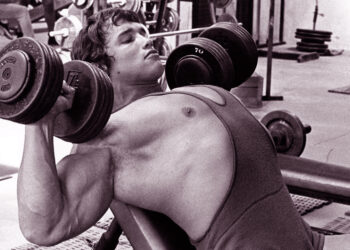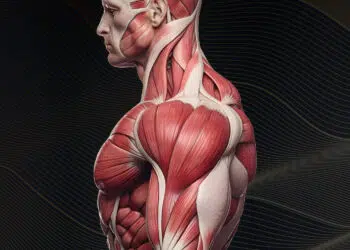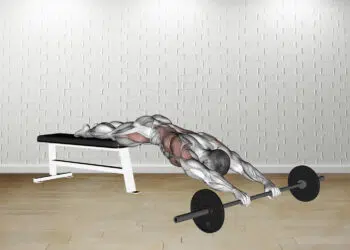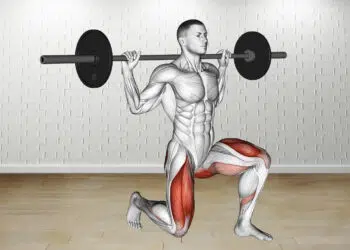The incline dumbbell bench press is a very effective compound exercise and it emphasizes the upper chest muscles near the clavicles. Dumbbells are very beneficial for developing unilateral strength and they also improve muscular imbalances as well. But they also help to build stabilizer muscles and they allow you to move through a more natural range of motion and movement.
So, dumbbells should be a staple in your chest training routine as the benefits are more than worth it. And training with dumbbells for the upper chest is also safer for your shoulders overall.
In This Exercise:
- Target Muscle Group: Clavicular (Upper) Pectoralis Major
- Type: Strength
- Mechanics: Compound
- Equipment: Dumbbells
- Difficulty: Beginner/Intermediate
Anatomy of the Incline Dumbbell Press
The Target: Upper Pectoral Muscles
While the incline dumbbell press predominantly works the upper pectoral muscles, it also engages the deltoids and the triceps. This triad of muscle engagement ensures a more rounded and comprehensive upper body workout.
Secondary Muscle Engagement
Apart from the primary muscles, the movement also engages the serratus anterior, anterior deltoid, and the triceps brachii, offering an added layer of muscle development.
The Proper Setup
Choosing the Right Bench Angle
An incline angle between 30° to 45° is optimal. This ensures maximum engagement of the upper pectorals while minimizing excessive strain on the deltoids.
Level Up Your Fitness: Join our 💪 strong community in Fitness Volt Newsletter. Get daily inspiration, expert-backed workouts, nutrition tips, the latest in strength sports, and the support you need to reach your goals. Subscribe for free!
Dumbbell Selection
Choose dumbbells that you can lift with proper form for at least 8-12 reps. Remember, it’s the technique, not the weight, that determines the effectiveness of this exercise.
Step-by-Step Execution
- Starting Position: Sit down on an incline bench with a dumbbell in each hand. Lay back and hold the dumbbells level with your shoulders, palms facing away from you.
- Press Upward: Exhale as you press the dumbbells upwards until your arms are extended above your chest.
- Slow Descent: Inhale as you lower the dumbbells in a controlled manner back to the starting position.
- Maintain Form: Ensure your elbows are slightly below your shoulders and not flared out.
Watch how to do the incline dumbbell bench press:
Variations & Tips:
- You can adjust the bench to a 30 or 45-degree incline for an effective workout.
- Avoid locking out your elbows during the top of the positive portion of a repetition.
- The incline dumbbell bench press emphasizes the upper chest muscles but it’s also a great overall chest exercise.
Other Variations of The Incline Dumbbell Press
Incorporating diverse incline press variations can invigorate your chest workouts, ensuring you achieve well-rounded muscle development. Let’s explore these variations further.
Barbell Incline Press
This classic compound movement harnesses a barbell to target the upper chest region. The stability offered by the barbell allows users to typically lift more weight compared to dumbbells.
How to:
- Starting Position: Lie on an incline bench with your hands gripping the barbell slightly wider than shoulder-width, palms facing forward.
- Unrack and Lower: Carefully lift the bar from the rack, holding it above your chest. Gradually lower it towards your upper chest.
- Press Upward: Drive the bar back upwards, extending your arms fully.
Tips:
- Keep your feet firmly grounded and engage your core throughout.
- Avoid completely locking out the elbows at the apex to maintain tension on the muscles.
Kettlebell Incline Press
Leveraging kettlebells adds an element of instability, compelling stabilizing muscles to work harder, thus enhancing the overall workout’s effectiveness.
How to:
- Starting Position: Recline on an incline bench clutching a kettlebell in each hand, with the weight resting on the back of your hands. Start with the kettlebells aligned with your shoulders.
- Press Upward: Powerfully extend your arms, propelling the kettlebells skyward.
- Controlled Descent: With control, retract the kettlebells to the commencement position.
Tips:
- Maintain straight and fortified wrists throughout the motion.
- Focus on controlled movements to maximize the benefits of kettlebells.
Single Arm Incline Press
The single-arm variation allows for unilateral training, addressing and rectifying potential strength discrepancies between the left and right sides of the chest.
How to:
- Starting Position: Lie on the incline bench grasping a dumbbell in one hand. Your free hand can rest on your midsection or grip the bench for added stability.
- Press Upward: Methodically press the dumbbell upwards until your arm reaches full extension.
- Lower with Care: Gently return the dumbbell to its original position.
Tips:
- Continuously engage your core to deter any unwanted twisting of the torso.
- Always commence with your non-dominant side to determine an appropriate weight and repetition range.
Incline Dumbbell Fly
This exercise stretches and contracts the chest muscles by employing a flying motion, isolating the pectorals more than a traditional press.
How to:
- Starting Position: Start on the incline bench holding a dumbbell in each hand above your chest, with palms facing each other.
- Open Your Arms: Lower the weights out to your sides in a broad arc, keeping a slight bend in your elbows.
- Contract and Lift: Engage the chest to return the weights to the starting position.
Tips:
- Keep a consistent elbow bend throughout the movement.
- Concentrate on squeezing the chest muscles as you elevate the dumbbells.
Incline Hammer Press
The hammer grip variation places the emphasis on a different part of the chest and can reduce strain on the wrists.
How to:
- Starting Position: Lie on the incline bench with a dumbbell in each hand, palms facing each other.
- Press Upward: Elevate the dumbbells skywards, retaining the ‘hammer’ grip.
- Controlled Descent: Lower the dumbbells methodically to the starting position.
Tips:
- The unique grip can offer relief to those experiencing wrist discomfort.
- Ensure you engage the chest muscles, especially during the peak of the lift.
Incline Dumbbell Press with Neutral Grip
This variation homes in on the inner chest, offering an alternative motion that can be gentler on the shoulders.
How to:
- Starting Position: Take your position on the incline bench, holding the dumbbells with palms facing one another.
- Press Upward: Drive the dumbbells upwards, adhering to the neutral grip.
- Descent: Ease the dumbbells back to their initial position.
Tips:
- Full range of motion is crucial to stimulate the entire muscle.
- Those with shoulder issues might find this variation particularly beneficial.
Close-Grip Incline Dumbbell Press
Focusing on the triceps and inner chest, this variation requires pressing the dumbbells while they remain in contact, presenting an added challenge.
How to:
- Starting Position: Lie on the incline bench, clutching the two dumbbells so they touch, palms facing away.
- Press Upward: Extend your arms, pushing the dumbbells overhead, ensuring they remain in contact.
- Slow Descent: Ease the weights back to the starting position, maintaining their touch.
Tips:
- Keeping the dumbbells in contact throughout heightens tension on the muscles.
- The emphasis on the triceps makes it an excellent exercise for arm development.
Read more on close grip dumbbell press.
Including these variations in your fitness routine ensures multifaceted chest development. Always emphasize proper technique and form to optimize gains and avert injuries.
Common Mistakes and How to Avoid Them
Flaring the Elbows
Avoid flaring your elbows out to the sides. This can put undue strain on the shoulder joint. Instead, keep your elbows at a 45° angle to your body.
Arching the Lower Back
Maintaining a neutral spine is paramount. Engage your core and avoid arching your lower back.
Using Momentum
Lifting too fast or using a swinging motion reduces the exercise’s effectiveness. Emphasize a controlled movement throughout.
Enhancing Your Incline Dumbbell Press
Progressive Overload
Gradually increase the weight of the dumbbells as your strength improves, ensuring you maintain proper form.
Incorporate Variations
Introduce variations such as the incline dumbbell fly or adjusting the bench’s incline angle to target different parts of the chest.
Pair with Complementary Exercises
Consider combining this press with exercises like push-ups, bench presses, and chest flies for a comprehensive chest workout.
Wrapping Up
Diversifying your incline press exercises ensures comprehensive chest development and strength. Prioritize proper form over lifting heavy, ensuring consistent growth without injuries. By incorporating these variations, you’ll continually challenge your muscles, promoting effective and dynamic workouts. Stay committed, and watch your upper body strength and aesthetics soar.
Interested in measuring your progress? Check out our strength standards for Bench Press, Incline Dumbbell Fly, Push Ups, and more.

